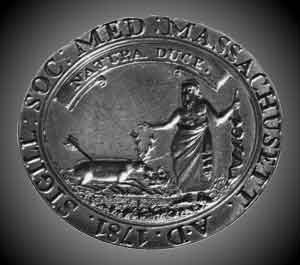One Common Seal: A Historical Look
One of the earliest acts of the Society was to implement the
provision of the charter that "the Fellows shall have one common
seal, and power to break, change and renew the same at their
pleasure."

When was the seal designed?
On April 17, 1782, Nathaniel Walker Appleton, John Warren
and Cotton Tufts were appointed "to invent a device and motto for a
seal," and three months later, on July 18, 1782, presented "several
devices" to nine other members, including Samuel Danforth.
The choice of the committee was a "figure of Aesculapius in his
proper Habit pointing to a wounded Hart nipping the Herb proper for
his cure with this motto vivere natura," and the members
present approved the design, but voted to change the motto to
natura duce. The completed seal was accepted by the
Society on April 9, 1783.
Who made the seal?
Oral tradition has it that Paul Revere engraved the seal, but there
is no direct evidence that he did so. However, in a 1963 article in
the New England Journal of Medicine, Robert W. Buck argues
that "Paul Revere would have been the natural choice of the
committee and Society to engrave the design." Danforth, Buck
relates, "was one of Revere's steadiest customers, as well as his
personal physician." No less than 26 items are charged to Dr.
Danforth in Revere's day book accounts from 1772 through 1796,
eight of which were ordered in 1783. Dr. Warren was an old friend
who had closely associated with Revere from the earliest days of
the Revolutionary movement, and his name appears frequently in the
day book as a customer.
Where is the seal now?
The original seal was impressed upon a disc of red sealing wax
covered with a thin paper wafer, which was affixed to official
documents. In 1916, a duplicate of the seal on a hand-lever type,
designed to emboss the seal directly into a sheet of paper, took
over the official duties of the original seal. It is now on
permanent loan to the Museum of Fine Arts in Boston, in its "Art of
the Americas" collection.
